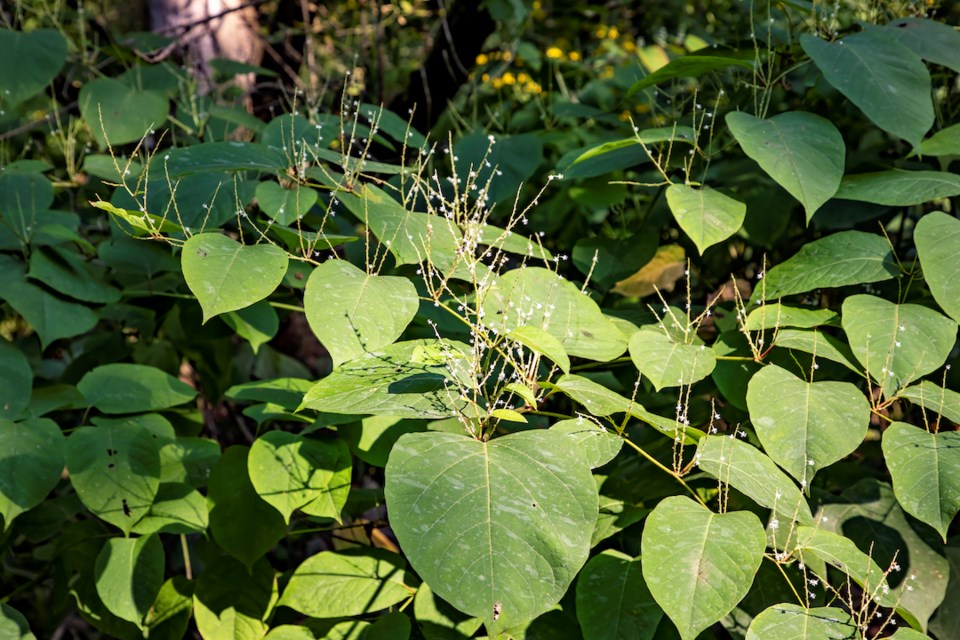Some residents of Roberts Creek, including beekeeper James Budd, are concerned about the herbicides being used in the area to help control knotweed, an invasive species which crowds out natural plants, can grow through asphalt and concrete and is extremely difficult to kill.
Budd says his daughter was running on Lockyer Road the other week when she saw a small sign in a ditch warning Roundup was going to be “applied” to the knotweed growing there, which is surrounded by blackberries. Budd adds, there was a phone number included on the sign for the Ministry of the Transportation and Infrastructure, but when he tried to call, it was out of service.
“They didn't say spray, they said ‘application’ of Roundup,” says Budd. “It's the most widely used herbicide on the planet Earth, and it uses glyphosates, which kill broadleaf weeds.”
Roundup restrictions only cover domestic use in most cases
Roundup is banned outright or restricted for domestic use in many North American cities, including Sechelt, Vancouver, Victoria, Seattle and San Francisco, the entire province of Quebec and many European cities. According to the Ministry of the Environment and Climate Change Strategy, the City of Vancouver has only banned glyphosate use for cosmetic purposes and allows its use for treatment of invasive species, including knotweed. It adds, this is similar to all municipal pesticide bylaws that have been enacted by other cities.
According to research findings from the University of Texas published in Proceedings of the National Academy of Sciences in 2018, glyphosate can affect the microbiota of honeybees, which tend to forage in and around weeds. The bees don’t die immediately but instead become more vulnerable to deadly infections.
A second study published in the Multidisciplinary Digital Publishing Institute, found the ingestion of food containing high concentrations of glyphosates resulted in a higher percentage of disoriented foragers. The study noted, the sublethal effects on their learning abilities could impact not only the foraging efficiency, but also the coordination of collective activities within the colony.
“So, they don’t know how to navigate,” says Budd. “The nectar flow is ending now, but it was flowing last week. And, my bees were just flying like crazy, visiting weeds, blackberries, you name it. They broadly use everything in the ditches,” says Budd. “They've been studying the impacts and we all know that pollinators across the planet have been compromised. It’s just mind numbing to me.”
Provincial Pest Management Plan
In January, the Ministry of Forests announced a five-year pest-management plan for southern and coastal B.C., to help combat invasive species, which have the potential to displace native seeds, decrease biodiversity, reduce food for wildlife and more. The plan is intended to provide guidelines for invasive pest management on provincial public lands.
At the time the ministry told the Coast Reporter in an email that invasive species are recognized globally as a significant threat to biodiversity. The plan also lists more than 20 herbicide active ingredients, which may be prescribed, including glyphosate, known for its broad-spectrum weed control, as well as when and where use of each chemical is allowed.
According to the plan, glyphosate products may be used up to one metre away from the high-water mark if used on invasive plants. Glyphosate products can also be selectively applied up to the high-water mark of a temporary, free-standing body of water and over a dry stream that is not fish-bearing.
For all other herbicides, a 10-metre, pesticide-free zone must be maintained away from the high-water mark, unless the label of that herbicide product requires a greater buffer zone. Also covered in the plan are procedures to protect First Nations interests in traditional food/medicine gathering and culturally significant areas.
Glyphosate deemed safe by Health Canada
In response to inquiries last week from the Coast Reporter, the Ministry of the Environment and Climate Change Strategy, said in an email that pesticides are regulated by Health Canada and only authorized if scientific evidence confirms they won’t harm human health or cause adverse impacts to the environment. Registered pesticides are regularly re-evaluated to confirm safety standards and typically only used when other methods of removing competing vegetation aren’t working. As well, Health Canada recently reconfirmed that based on American and European studies, glyphosate is safe when used properly.
In B.C., pesticides are regulated under the Integrated Pest Management Act (IPMA) and the Integrated Pest Management Regulation, which sets additional requirements to ensure the safe and proper use of federally approved pesticides.
Under the IPMA, use of glyphosate products in forestry, industrial vegetation management, and invasive plant control programs requires an authorization, which includes registering a Pest Management Plan, which requires First Nations and public consultation. Once registered, PMPs are valid for five years.
According to the ministry, authorization holders are required to follow additional requirements including setbacks from sensitive areas (including fish-bearing streams), use of alternatives before pesticides are applied and use of mandatory Integrated Pest Management practices.
The ministry notes, municipalities can restrict pesticide use on landscaped areas and turf on residential and municipal property, but not sales for industrial/commercial use.



